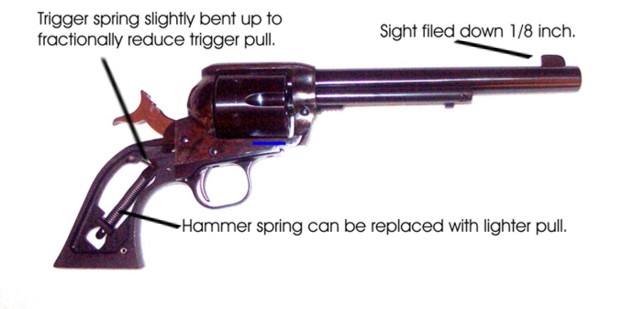After you get your handguns, you may want to make some changes. An easy change which can dramatically alter the look of your gun is to replace the grips, usually only requiring removing one screw. Vendors at gun shows offer a wide variety of grips ranging from fancy ivory to other woods. (While you have the gun grips off you might want to inspect what you see...it may look like the picture below of a Ruger Vaquero--on the Vaquero, you can see the hammer spring--also called the mainspring, but the trigger spring is harder to see.)
For a new gun from the factory, as well as for some used guns, you may want to find a gunsmith in your area who specializes in cowboy shooting "action jobs." An action job usually involves checking or replacing the hammer or trigger springs which may be tight or require more pull than necessary. Your gun may also need some filing down of action parts that are rubbing against another part. An action job will make a dramatic change in the smooth operation of almost any gun. (Some dealers sell guns that have already had an action job.) Expect to pay about $75 for an action job.
If you have any mechanical skills, there are a few things you might want to try yourself to improve your handgun performance. Unless you are very experienced in working with guns, I'd recommend using a gunsmith for rifles and shot guns. If doing this work yourself, I'd also recommend getting a book with some gunsmithing hints specific to your gun. Most manuals that come with your gun are not specifc enough for this purpose.
If you have a fixed sight on your handgun, you may need to file down the front sight for accuracy. Don't try to file down too much at once. It is far better to file down a little, try it out, and then file down more if needed. (A gun blue stick can cover up the shiny surface which results from the filing.)
If your hammer or trigger springs are tight, you can purchase "after market" springs with less stiffness (measured in pounds of trigger or hammer pull). Replacing springs can can be a little tricky, especially when these springs (or other hidden springs when you dismantle the gun) can pop out and get lost. A gunsmith book may also offer other hints for reducing the strength of your springs without replacing them. Some springs can be cut shorter or, in the case of the photo of the Ruger Vaquero below, by bending the trigger spring (a suggestion by Jerry Kuhnhausen in his shop manual for Ruger Single Action Revolvers.) The big caution here is not to do too much to alter the factory springs since changes could result in a hammer or trigger spring with a lower pull that could increase the accidental discharge of the weapon.
The picture below illustrates some "easy" changes on the Ruger Vaquero for the beginning gunsmith.

The filing of parts for less friction requires a little bit more skill (and the proper metal files or "stones"...the right tools are always important for any task!) If you want to try this, it is suggested that you fire the gun a number of times so that when you dismantle the gun you can more easily see where it is rubbing against other parts.
One of the benefits of doing some of your own gunsmithing (in addition to saving money) is that you become more familiar and knowledgeable about your gun's operation. The personal satisfaction in improving your gun's operation is still another benefit.